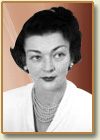Frozen Foods - Clarence Birdseye
When we crave fresh fruits and vegetables in the middle of winter, we can thank Clarence Birdseye for the next best thing. Clarence Birdseye invented, developed, and commercialized a method for quick-freezing food products in convenient packages and without altering the original taste. While Clarence Birdseye has become a household name, his process has evolved into a multi-billion dollar industry.
Clarence Birdseye was born in 1886 in Brooklyn, New York A taxidermist by trade, but a chef at heart, Clarence Birdseye wished his family could have fresh food all year. After observing the people of the Arctic preserving fresh fish and meat in barrels of sea water quickly frozen by the arctic temperatures, he concluded that it was the rapid freezing in the extremely low temperatures that made food retain freshness when thawed and cooked months later.
In 1923, with an investment of $7 for an electric fan, buckets of brine, and cakes of ice, Clarence Birdseye invented and later perfected a system of packing fresh food into waxed cardboard boxes and flash-freezing under high pressure. The Goldman-Sachs Trading Corporation and the Postum Company (later the General Foods Corporation) bought Clarence Birdseye’s patents and trademarks in 1929 for $22 million. The first quick-frozen vegetables, fruits, seafoods, and meat were sold to the public for the first time in 1930 in Springfield, Massachusetts, under the tradename Birds Eye Frosted Foods®.
Clarence Birdseye turned his attention to other interests and invented an infrared heat lamp, a spotlight for store window displays, a harpoon for marking whales, then established companies to market his products.
The blog is mainly a general knowledge page for all age groups who are interested in improving their knowledge. I have tried to make the explanations as simple as I can. I have made use of tht for gathering the facts.
Pages
▼
Wednesday, January 19, 2011
Marion Donovan..Inventor of the disposable diaper.
Marion Donovan
Inventor of Disposable Diapers
 Born in Fort Wayne, Indiana in 1917, Marion Donovan was instilled with an inventive spirit at a young age. She spent the greater part of her childhood hanging around the manufacturing plant run by her father and uncle, two men who combined to invent, among other things, an industrial lathe for grinding automobile gears and gun barrels.
Born in Fort Wayne, Indiana in 1917, Marion Donovan was instilled with an inventive spirit at a young age. She spent the greater part of her childhood hanging around the manufacturing plant run by her father and uncle, two men who combined to invent, among other things, an industrial lathe for grinding automobile gears and gun barrels.Years later, as a post-World War II housewife and mother of two in Connecticut, Donovan would make good use of the ingenuity that she had observed in her youth. Frustrated by the thankless, repetitive task of changing her youngest child's soiled cloth diapers, bed sheets and clothing, she decided to craft a diaper cover to keep her baby – and the surrounding area – dry. Donovan sat down at her sewing machine with a shower curtain and, after several attempts, she completed a waterproof diaper cover.
Unlike the rubber baby pants that were already on the market, Donovan's design did not cause diaper rash and did not pinch the child's skin. The soon-to-be famous female inventor subsequently perfected her invention, adding snap fasteners in place of the dangerous safety pins that were commonly used. Donovan named her diaper cover the "Boater" and explained that "at the time I thought that it looked like a boat."